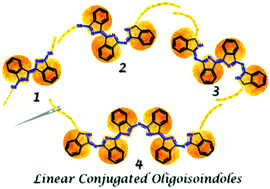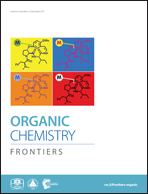Novel, linear oligoisoindole compounds with a conjugated electronic structure†
Abstract
Unprecedented linear oligoisoindole derivatives including diisoindole, triisoindole, tetraisoindole, and hexaisoindole species, representing the new family rather than the traditional cyclic oligoisoindole ones, have been synthesized and spectroscopically characterized for the first time. Variable temperature NMR experiments in combination with DFT calculations reveal the tautomerization of the N–H protons between the outer and inner isoindole units in triisoindole, tetraisoindole, and hexaisoindole species at room temperature. The conjugated electronic structure nature of these oligoisoindole compounds has been clearly clarified on the basis of their single crystal molecular structure, electronic absorption, fluorescence, and electrochemical properties together with theoretical calculations. Moreover, the π Mayer bond order calculation suggests that these oligoisoindole compounds have two types of strong conjugated regions including the delocalized conjugated line across the whole skeleton and the localized conjugated circles at the benzene moieties, which are united together into a whole conjugated system by weak π linking bonds. In particular, the π bonds that pervade over all the linear conjugated oligoisoindole skeletons are comparable to those in the traditional cyclic oligoisoindole skeletons. This, in combination with the existence of the well-defined coordination moiety/moieties for these linear oligoisoindoles, suggests their promising application potential in diverse fields including sensors and electronic devices as their cyclic counterparts.



 Please wait while we load your content...
Please wait while we load your content...